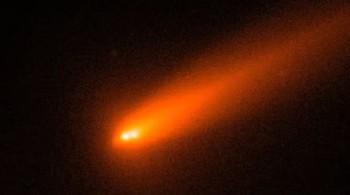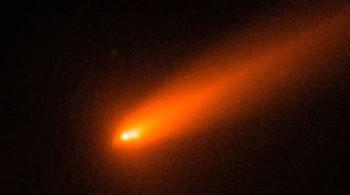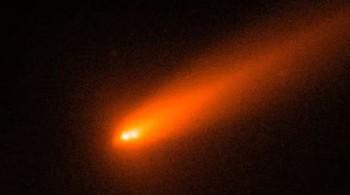
Comet C/2025 K1 (ATLAS) breaks into 3 after coming close to Sun
In a breathtaking display of celestial mechanics, Comet C/2025 K1 (ATLAS) has broken into three pieces after swinging too close to the Sun. This extraordinary event was captured by astronomers using Italy’s Copernicus telescope, providing a unique glimpse into the dynamic and unpredictable world of comets.
The comet, which was discovered earlier this year, had been closely monitored by astronomers as it approached the Sun. On October 8, the comet made its closest approach to the Sun, passing within a mere 1.2 astronomical units (AU) of the solar center. One astronomical unit is the average distance between the Earth and the Sun, which is approximately 93 million miles or 149.6 million kilometers.
As the comet drew close to the Sun, its nucleus began to experience intense heat and radiation, causing it to become unstable. This instability ultimately led to the comet’s break-up into three distinct pieces. The two larger chunks, which are estimated to be around 1-2 kilometers in diameter, have drifted approximately 2,000 kilometers apart from each other. A smaller third piece can be seen to the left of the pair, highlighting the complex and dynamic nature of the comet’s fragmentation.
The break-up of Comet C/2025 K1 (ATLAS) is not unprecedented, as comets have been known to fragment or even disintegrate when they approach the Sun. However, the capture of this event using Italy’s Copernicus telescope provides a rare and fascinating insight into the processes that govern the behavior of comets.
The images captured by the Copernicus telescope show the three fragments of the comet in stunning detail, with the two larger chunks appearing as bright, elongated objects. The smaller third piece is visible as a fainter, more diffuse object to the left of the pair. The images also reveal the comet’s tail, which is composed of gas and dust that has been ejected from the comet’s nucleus as it approaches the Sun.
The break-up of Comet C/2025 K1 (ATLAS) has significant implications for our understanding of comets and their behavior. Comets are thought to be remnants from the early days of the solar system, and their composition and structure can provide valuable insights into the formation and evolution of the solar system. By studying the fragmentation of comets like C/2025 K1 (ATLAS), astronomers can gain a better understanding of the processes that govern the behavior of these enigmatic objects.
In addition to its scientific significance, the break-up of Comet C/2025 K1 (ATLAS) is also a reminder of the awe-inspiring beauty of the universe. The images captured by the Copernicus telescope are a testament to the incredible complexity and dynamic nature of the celestial world, and serve as a reminder of the many wonders that await us in the vast expanse of space.
As astronomers continue to study the fragments of Comet C/2025 K1 (ATLAS), they will be able to gain a better understanding of the comet’s composition, structure, and behavior. This knowledge will be invaluable in helping us to better understand the solar system and its many mysteries, and will undoubtedly lead to new and exciting discoveries in the years to come.
In conclusion, the break-up of Comet C/2025 K1 (ATLAS) is a remarkable event that has provided a unique glimpse into the dynamic and unpredictable world of comets. The images captured by the Copernicus telescope are a testament to the incredible beauty and complexity of the celestial world, and serve as a reminder of the many wonders that await us in the vast expanse of space.





